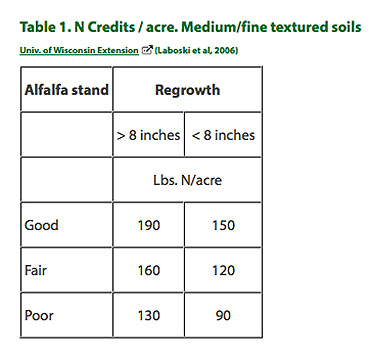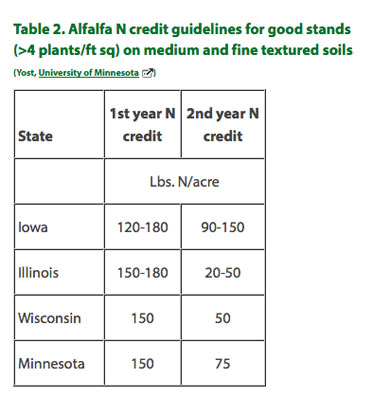For the dairy producer that needs more high-quality alfalfa feed, it’s a quick and easy answer. If they need the feed, go get it, then plan on planting the corn afterwards.
The early spring provides time to harvest the alfalfa and still have nearly full potential for the corn crop if planted before May 15. However, producers should consider some of the following points when making the decision about cutting:
• Alfalfa that has a height of 24 to 30 inches will usually have neutral detergent fiber (NDF) levels between 34 and 37 percent and have forage quality in the 160 to 190 relative feed quality (RFQ) range and would have a price near $235 per ton (dry hay).
• There is a shortage of high-quality dairy hay available for purchase due to the drought and flooding conditions that occurred during 2012.

• Alfalfa regrowth does make a difference in nitrogen (N) credits. University of Wisconsin research indicates that regrowth of alfalfa over 8 inches will provide an extra 40 lbs of N per acre (see Table 1).
• What’s the value of the additional 40 N credits? When analyzing the amount of N left in the field following alfalfa plowdown, consider the recent price trends in N. As an example, urea is near $775 per ton and 28 percent N is nearing $450 per ton. This puts the cost of N between $0.80 to $0.85 per pound and roughly $34 per acre.
• There is a substantial difference in N credit between sandy coarse soils and finer textured soils.

Recent university research suggests that when adequate stands of alfalfa are present (four plants per square foot), first-year corn grain yield is often maximized without fertilizer N, regardless of alfalfa regrowth management or timing of incorporation, but small N applications may be needed to maximize silage yield.
However, earliler research done at the Kellogg Biological Station indicated that alfalfa killed in the fall lost significant N since the fall was mild and that spring will result in less N loss than fall killed alfalfa because of the danger of leaching nitrate during the winter and early spring.
If producers decide to rotate their alfalfa fields to corn, they may want to consider adding 40 lbs of N if they are in a sandy, coarse-textured soil. Additional N above the 40 lb level would not be recommended.
If producers are on the fence over whether to keep or rotate a good stand of alfalfa, this spring has been non-typical thus far, and we may see an increased shortage of hay in Michigan if adequate moisture doesn’t occur. FG
—Michigan State University Extension press release










